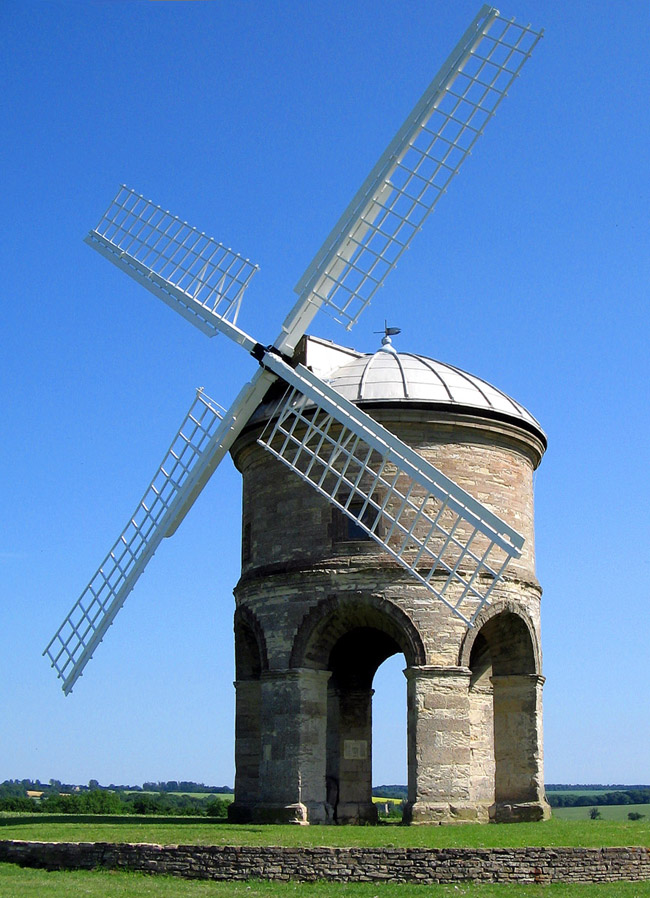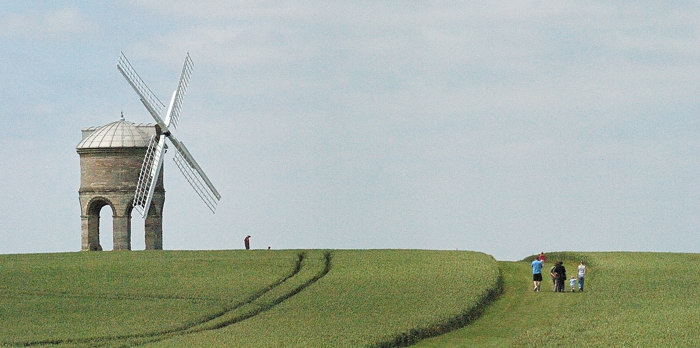Chesterton Windmill
The Windmill Chesterton is a native of the 17th century stone tower windmill with a unique six times the arc base near the homonymous village Chesterton, Warwickshire. It is the only windmill of this kind in the world and a conspicuous landmark in the southeast of Warwickshire.
History
The rare windmill has been about 380 years one of the most famous landmarks of Warwickshire. It is located on a small hill above Chesterton, eight kilometers south-east of Warwick and near the Roman Fosse Way. The construction is Sir Edward Peyto, Mr. Chesterton Manor, attributed to who built the mill in the years 1632-1633. During this time, John Stone, a pupil of Inigo Jones ' as the architect of the new Manor House in Chesterton was probably also involved in the plans for the windmill. Sir Edward Peyto was a mathematician, astrologer and architect of his mill. There was a long time assumptions, the building was originally acts as an observatory. Entries in the Land Registry Office in Warwick prove, however, that it has always acted in the building to a windmill. This makes it the oldest tower windmill in England with original gear parts. The vertical shaft was renewed in 1776 (date carved ), 1860, a new roller ring frame ( turntable ) and cap frame installed. By 1910 the mill was due to a severe Krühwerkdefekts of their last miller, William Haynes, shut down because they could no longer turn into the wind. Haynes joined the windmill of Harbury ( tower received ), one mile east away. This ended their professional continuous use. Photos from the 1930s show the mill with sailing clothing - it was to ground off and when the wind blew favorably. During this time, repairs to the wings to have been carried out. In the early 1950s broke off one of the wings of the mill, which was repaired - 1958 the wing cross was again intact. Since the 1960s, it is owned by the County Council Warwickshire ( Warwickshire County Council ), to take care of their receipt. It was not until 1966-1971 found the necessary repairs primarily on the cap and on the wing cross from the National Trust place, and the mill opened its doors annually thereafter for a few days in the summer for interested visitors. In September 2006, plunged down a wing and injured a visitor easily. Then the mill was closed to visitors, in the following year began re- repairs. Since autumn 2007, it is full of milling quality again.
Description and construction
The squat tower mill with a diameter of just under seven meters and a cap of approximately eleven meters was built from local limestone and sandstone, its design and its drive are unique in the world. He stands on a six semicircular arcs whose pillar again form part inward current arcs with a common center, almost a six-fold cross vault. A sandstone frieze runs above the arches of the tower, below the four windows. Two of the windows are small, the two larger ones are provided with stone bars. In a small skylight roof cap is recessed relative to the wing axis outlet that has above a small plaque with the letters " EP 1632 ". The upper closed part of the tower of sandstone has, in addition to the open-access input ground two more mill heads on the first, lower or stone floor in 4.6 meters above the bottom shelf of limestone blocks with two grinding passes with frame and vat (English hurst frame, a rare component in English windmills ), the spur gear and bag lift cable ( runs through the bottom door) and a second, upper floor with lift or cogwheel, Bunkler, bag lift and parts of Krühwerks. The short vertical shaft and the Krühwerkhauptteile with wind direction indicators are housed in the rotatable cap, unusual in England Innenkrühsystem which rotates the cap by hand winch with spur and worm gear. Until 1930 a central wooden crate system was installed within the entrance floor between the sheets to store bags, plus there was an open wooden staircase that led to the trap door in the stone floor, and a rack for the bag lift. Because of repeated vandalism, these wood components have been removed. The cap roof, a wooden structure in the form of a round flat dome with a lead plate coating, received a harder aluminum sheet surface due to vandalism. A roller ring frame is recessed into the upper ring of walls, which can turn the cap easily. The wind direction indicator on the roof runs into the cap inside which at its lower end a turn indicator is sitting, which allows the miller to turn the mill into the wind without stopping the grinder. The sails gate wing ( 18 feet rod length with 42 m2 sail fabric ) run, as seen in most windmills around the world, from the outside counter-clockwise from the inside ( from the perspective of the miller " under the wind " ) to the right.
Mill in Newport, Rhode Iceland
In Newport, Rhode Iceland is a ruin from the late 17th century, which is called because of their resemblance to the Windmill Chesterton as Newport tower windmill. Its historical purpose is not secured to him it was especially in the 19th century, various speculations.










